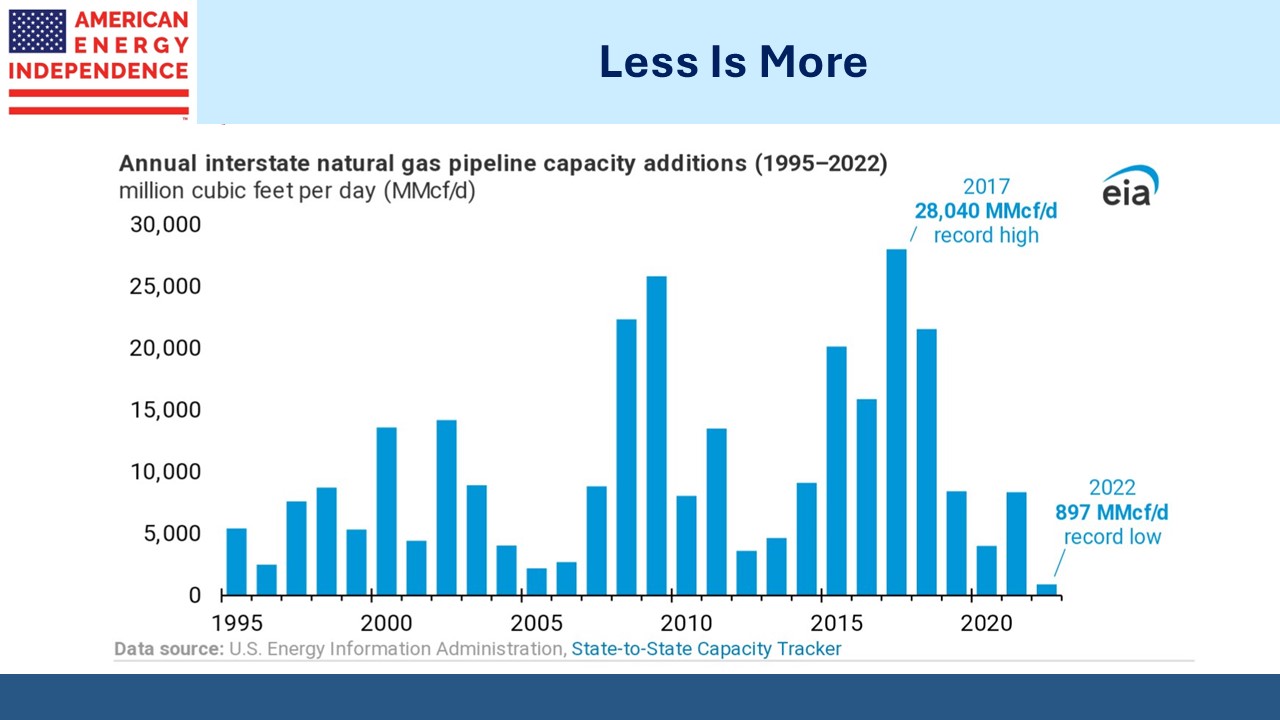Blue State Energy Policies
Oregon is typical of many liberal states in that it is reviewing the infrastructure plans of the utilities it regulates. The concern is that too much capital will be invested in new natural gas infrastructure that will subsequently result in “stranded assets” as renewables reduce natural gas demand. The fear is that poor capex decisions will saddle future ratepayers with the cost of un-needed infrastructure as cheap solar and wind gain share.
Renewables aren’t cheaper – that theory has been debunked by the rising price of electricity over the past couple of years (see The Inflationary Energy Transition). There’s a case that reducing CO2 emissions is a desirable public policy goal and pursuing it is worth more expensive electricity. Liberals rarely make this case, preferring instead to claim that weather-dependent power costs less in defiance of evidence to the contrary.
So the Oregon Public Utilities Commission is challenging assumptions about future natural gas demand, which they deem “unreasonably optimistic.”
Additions to US natural gas pipeline capacity were a record low in 2022, down 97% from the high five years earlier. It’s helping boost cashflow at pipeline operators because their capex is down but may not always be in the public interest.
By contrast, India’s PM Narendra Modi is pushing to turn India into a “gas-based economy.” The country’s largest steel mill is planning to invest $1BN to help it switch to natural gas, which will reduce its coal consumption and therefore India’s CO2 emissions.
The Indian Oil Corporation recently signed a long-term LNG deal with TotalEnergies, a key investor in NextDecade.
The White House pause on new LNG export permits impedes India’s energy objectives even though they’re in everyone’s interests. India’s JSW Steel is not going to use solar and wind to make steel.
This is why it’s correct to bet on continued growth in demand for US natural gas. The world is shifting to a more realistic energy transition which acknowledges it’ll take generations and that reducing coal consumption anywhere and everywhere is good. As policymakers and businesses adopt practical solutions, the US is well positioned to lead.
Several major European power companies are scaling back their renewables’ targets. Italian, Spanish and Portuguese electricity prices may be among the highest in the world, but they aren’t high enough to make such investments profitable.
“There has been a big reality check around renewables growth,” said Norman Valentine, head of renewables research at consultancy Wood Mackenzie.
It is against this backdrop that your blogger is replacing an old oil furnace with a new gas one. This requires the local gas company to upgrade our existing gas line to higher capacity, work that is mercifully still permissible in blue New Jersey. In New York, Con Edison requires anyone with a gas service request to accept the “Acknowledgement of the Climate Leadership and Protection Act” which sounds as if they’d rather you didn’t make such a request in the first place.
Heat pumps have outsold natural gas furnaces for the past two years. This doesn’t mean that more homes are installing heat pumps, because some homes may be using more than one unit. For example, we already have one natural gas furnace so will be adding a second.
Heat pumps, which run on electricity, use less energy and are cheaper to operate. This should mean they’ll eventually displace natural gas furnaces. However, their installation is complex and expensive. They also don’t work well with the cast iron radiators in our almost century-old home, which require large volumes of very hot water to operate effectively.
Heat pumps reportedly run less efficiently as it gets cold, when they rely on a backup heating element which is much less efficient. I’d be concerned that they wouldn’t keep the house as warm as I’d like – I have little tolerance for being cold, which is why I spend much of the winter in south Florida.
Unlike our gas furnace, a heat pump would be placed outside where it would be vulnerable to ice formation. Defrosting it would reduce the heat available for the house, probably just when it is most needed. They’re apparently also noisy. They use a longer operating cycle than gas furnaces which means they’re running more of the time.
The added gas infrastructure that will enable our additional gas furnace will not be stranded for at least as long as we’re living here. My criteria for a heating system begins with whether it will keep us warm enough. There’s no efficiency or cost benefit that would compensate for being cold. And any reduced emissions would be offset by one of China’s new coal-burning power plants within a few moments, so that doesn’t factor in at all.
I don’t want to be forced to rely on a heat pump in the future if I don’t think it’ll meet my needs.
Ray Dalio sees political polarization in America causing people to, “…move to different states that are more aligned with what they want.”
Energy policy in liberal states is one reason why.
We have three have funds that seek to profit from this environment:
